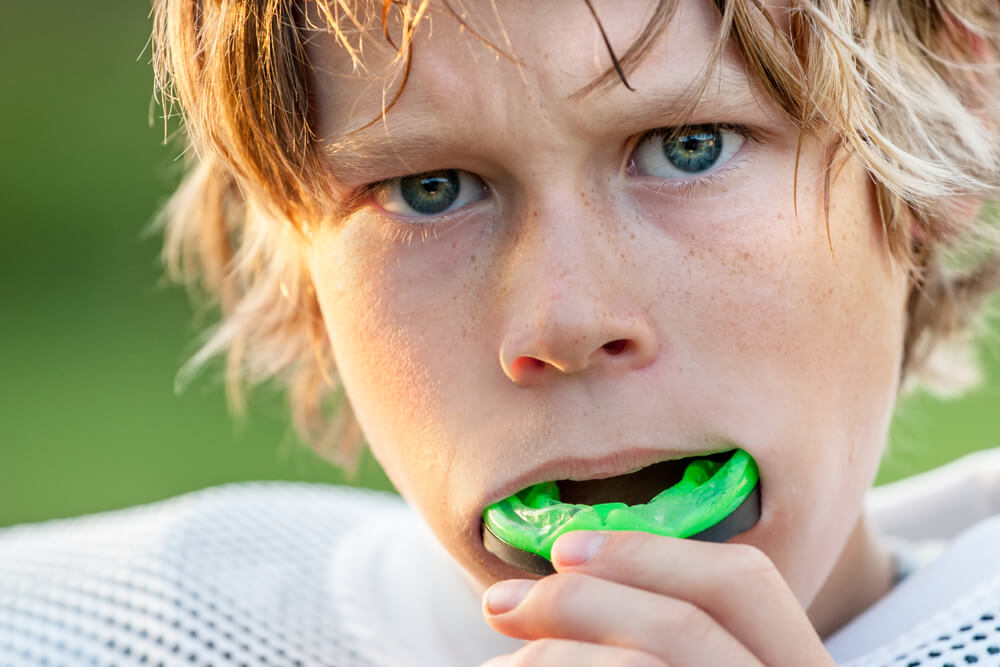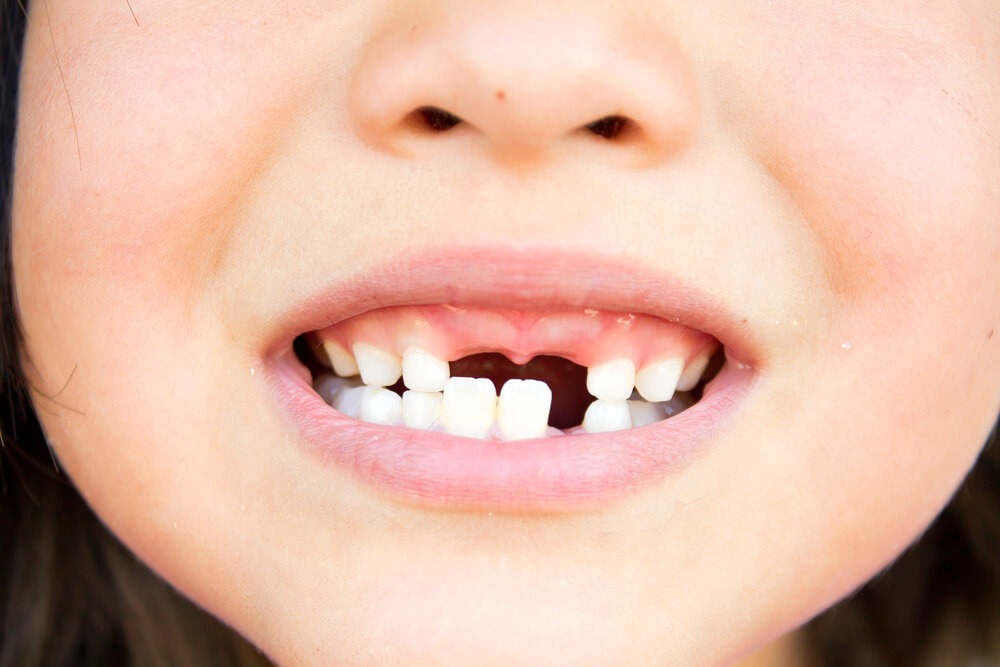In our years of offering braces in Overland Park and Olathe, we’ve seen our fair share of cut lips and broken hardware thanks to patients getting hit in the face with a ball or an elbow during a game when they weren’t wearing a mouthguard. Yet, it’s not just kids with braces who need to protect their teeth when playing sports. While braces certainly add to the risk of injury, even children (and adults!) wearing Invisalign, retainers, or nothing at all should be taking precautions. Avoiding tooth and mouth injuries in children while playing sports can be as simple as using protective gear like a mouthguard.
Sports and Dental Injuries
It’s estimated that between 13% and 39% of dental injuries happen while playing sports. Contact and collision sports are of particular concern when it comes to mouth and dental injuries in children but even solo recreational activities like skateboarding can put teeth at risk. While these injuries are rarely life-threatening, they can be painful, cause serious damage, and be costly to fix. Typical orofacial and dental trauma from sports includes soft tissue injuries (lacerations to the cheeks, lips and tongue), teeth getting chipped, broken or knocked out completely, dislocation of the temporomandibular joint (TMJ), root fractures and tooth luxation (tooth is still in the socket but has been dislodged and is in the wrong position either intruded, extruded or laterally displaced).
Wearing a fixed orthodontic appliance like braces adds another layer to this. Not only can braces cut to the inside of your child’s mouth during a collision, they can also hurt other players. If the braces are damaged, it may even increase the length of treatment time.
Sports-Related Mouth Protection
We can’t emphasize enough the importance of mouthguards for kids. Athletes are 60 times more likely to experience a dental injury when they’re not wearing one. There really isn’t a better means of avoiding kids’ tooth injuries during sports and as a bonus they’re fairly unobtrusive and cost-effective.
Mouthguards cushion blows to the mouth to protect the teeth, lips, tongue and cheeks and could reduce the odds of jaw fractures by dissipating forces. They act as a barrier between brackets and wires and the soft tissues in the mouth and keep appliances from getting broken. Contrary to some reports, there isn’t enough compelling evidence to say that mouthguards actually prevent concussions, so follow safety precautions and wear a helmet in addition to mouth protection for any activity involving speed or impact like football, hockey, skating or riding a bike.
So what kids’ sports require mouthguards? Unfortunately, not many make mouthguards mandatory. A study of high school athletes discovered that 40% of dental injuries from sports happened during baseball and basketball, neither of which routinely require a mouthguard. If there is any chance of trauma to the mouth or teeth, you should make it a rule that your child wear one. The American Dental Association recommends using a mouthguard for these sports:
- Acrobatics
- Basketball
- Bicycling
- Boxing
- Equestrian Activities
- Extreme Sports
- Field Events
- Field Hockey
- Football
- Gymnastics
- Handball
- Ice Hockey
- Inline Skating
- Lacrosse
- Martial Arts
- Racquetball
- Rugby
- Skateboarding
- Skiing
- Skydiving
- Soccer
- Softball
- Squash
- Surfing
- Volleyball
- Water Polo
- Weightlifting
- Wrestling
Choosing and Caring for Youth Mouthguards
You don’t necessarily need a specialized mouthguard to keep your child’s teeth safe. Any mouthguard will do the trick as long as it fits properly and is durable, resistant to tearing and easy to clean. You’ll know it’s a good fit if it’s comfortable, offers adequate coverage and doesn’t interfere with breathing or speaking. These are the three most common types:
- Stock Mouthguards – These pre-formed mouthguards are ready to wear straight from the package. Since fit is the most important quality you can look for, go with a brand that offers different sizes as one size certainly does not fit all.
- Boil and Bite Mouthguards – When placed in boiling water, these mouthguards soften up and can be molded to the shape of the mouth. Just be careful it doesn’t lock onto your child’s braces during the process as that can damage the brackets or wires.
- Custom Mouthguards – Most dentists recommend custom-fitted mouthguards especially for orthodontic patients. A dentist or orthodontist can make a mouthguard based on an impression of your child’s mouth for the perfect fit. This version does cost more and when your child’s teeth move thanks to their braces or Invisalign treatment, they’ll need a new one.
A boil and bite or custom-fitted mouthguard is usually the best bet. There are even brands that have cutouts for braces. Since mouthguards can be a breeding ground for bacteria, which can cause infection if your child has abrasions in their mouth, be sure to clean it. Brush it with a toothbrush and toothpaste after every use and once a week, soak it in antimicrobial denture cleaning solution. Store it in a well-vented case when it’s not being worn. If you opted for a boil and bite or stock mouthguard, replace it every two weeks or as soon as it gets sharp or jagged edges.
Emergency Dental Care for Kids
We know even with the best intentions, sometimes accidents happen. If your child forgot to wear a mouthguard or for some reason it didn’t perform as expected and they experience a dental injury, don’t panic. The majority of the time, the tooth can still be repaired or saved. Here are some of the more common kids’ teeth injuries and how to deal with them:
- Fractured Tooth – If the tooth is broken or chipped, have the child gently bite on a towel to stabilize what’s left and control bleeding. Take your child, along with any pieces of the tooth, to the dentist right away. To transport the tooth, store it in milk, under your little one’s tongue or wrapped in a gauze pad soaked in saline.
- Missing Tooth – Don’t touch the tooth’s root.  Instead, handle it by the crown. If it’s dirty, rinse it gently with water. If you can, place the tooth back into its socket and have your child bite down gently on a towel to hold it in place. Get to a dentist as soon as possible. A large percentage of teeth that are placed back into the socket within five minutes survive.
- Intruded Tooth – If the tooth looks short and is pushed into the bone, don’t try to pull it out or reposition it. Take the child to the dentist right away.
- Extruded or Laterally Displaced Tooth – If the tooth appears long or is pushed back or pulled forward, it will have to be repositioned using firm pressure from a finger. A dental professional is best equipped to do this.
For any dental injury, visit the dentist as soon as possible, preferably within two hours, for the best outcome. Always seek immediate medical attention if your child develops a fever, has difficulty swallowing or breathing, the bleeding doesn’t stop after applying pressure for 10 minutes, you have any concerns or feel that something isn’t right as it could indicate a more serious issue. Â
When you stop in at Moon Orthodontics for a consultation or check-up, let us know about the sports your child is playing and we’ll help them choose the right mouthguard for their needs. Usually a mouthguard on the top teeth will suffice, however, depending on their particular situation, sometimes we also recommend one for the bottom teeth as well. If your child’s braces get damaged while playing sports, contact us right away and we’ll get them in for a repair appointment. In the meantime, follow our comfort care tips to temporarily remedy the problem though it can usually be avoided altogether with the right mouth protection. Mouthguards are a relatively small investment for a huge pay-off: a healthy, intact smile.
 Free Consult
Free Consult

